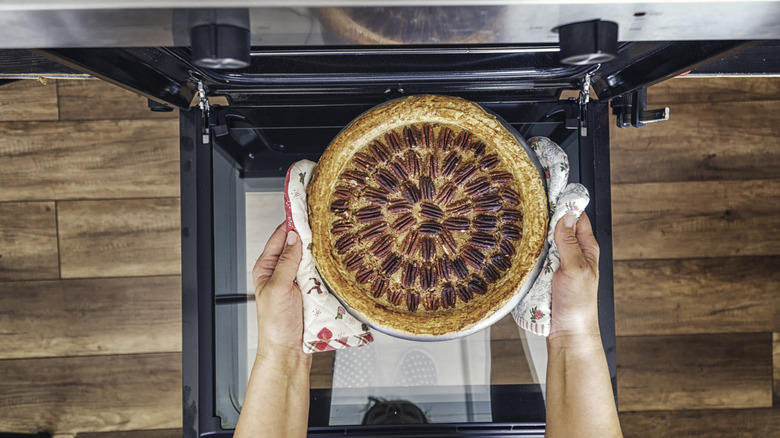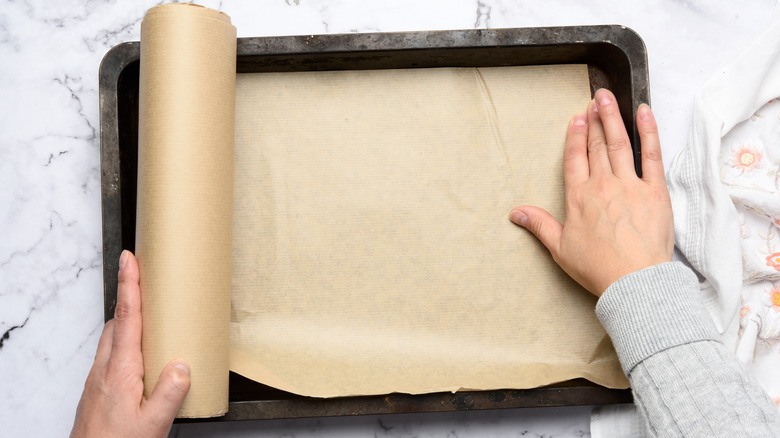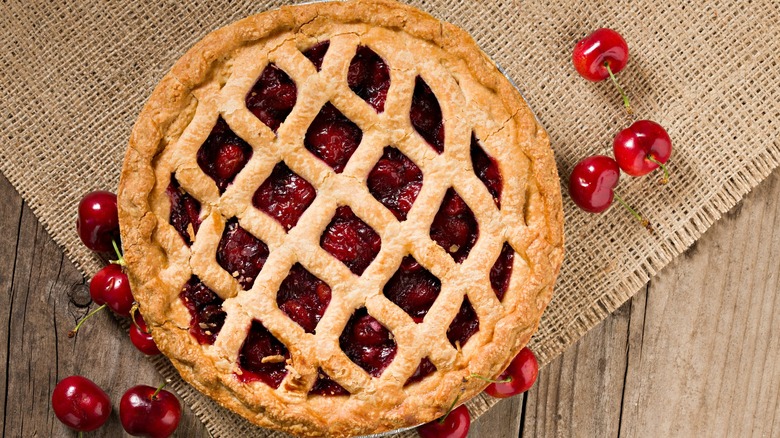The Sheet Pan Trick To Keep Your Oven Clean While Baking Pie
Those who enjoy homemade pies know that, even though the end result is worth it, there's a lot that goes into creating the cozy, warm dessert like patience, love, and oftentimes, a mess to clean up. The dishes, the fruit peels, and the flour all over that counter are the easy parts; however, it's cleaning up the oven after the pie is baked that's the real chore. Fruit pies, in particular, tend to leak while they're being baked, dripping contents on the oven racks and the bottom of the oven, leaving a baked-on goo that sticks like cement.
But, there's a trick to avoid this that is quite simple: Just place your pie dish on a baking sheet when you place it in the oven. Anything that drips or spills over will fall right onto the pan, which you can then soak in water until the baked-on mess scrapes right off. The bonus to this strategy is that, when you go to remove the pie from the oven, you will be grabbing the sheet pan and not your pie dish, which also inevitably avoids your bulky oven mitt from gouging your perfectly formed pie crust.
Double the protection with foil or parchment paper
Even with the helpful baking sheet hack for making pies, there's another trick you can do to prevent any magma-temperature, sticky fruit juice from leaking onto the pan. Add another layer of aluminum foil or a sheet of parchment paper on it first, so you can easily toss away the drips, leaving a perfectly clean baking sheet — and nothing to scrub away.
You don't want to use wax paper, however, as it could melt or, worse, catch on fire. If you are concerned about your pie not getting full heat circulation due to the extra layer of metal on the pan, you could place your pie dish on one oven rack and place the lined sheet pan on the one underneath. This way, it will still catch any drippage, although some liquid might drip onto the rack itself and need to be cleaned.
Pie leakage doesn't mean that you've necessarily done anything wrong when you're preparing the dessert. Simply put, as the ingredients heat up in the oven, they will expand, releasing moisture. Even if you've cut vent holes in the crust, the liquid still might bubble up and spill out of the sides of the pie dish. But there are some things you can do to help minimize any eruptions of filling.
Prevent pie spillage beforehand
You can make it more difficult for the pie liquid to find a way out of the pie dish by ensuring the edges are well-sealed. At the same time, you'll want to leave room for the needed heat expansion; cutting some of the aforementioned slits in the top of the pie is a great way to do this. Some filling may still seep out of the top, but it typically stays there and doesn't end up on the bottom of your oven. Similarly, you can place a pie bird (also known as pie vent, pie whistle, or pie funnel) through the top crust — this allows the steam inside to escape out of the top.
However, try not to overfill the bottom crust with fruit and consider mixing in a natural thickener like cornstarch or tapioca flour, which will help firm up the liquid and also keep the filling together once the pie is baked (preventing liquid from going all over the place when you cut into it). Finally, placing a pie shield around the edges of the crust may somewhat reduce any spillage from coming out of the sides as well. All of these methods can be used for fruit pies, cream pies, even pot pies.



